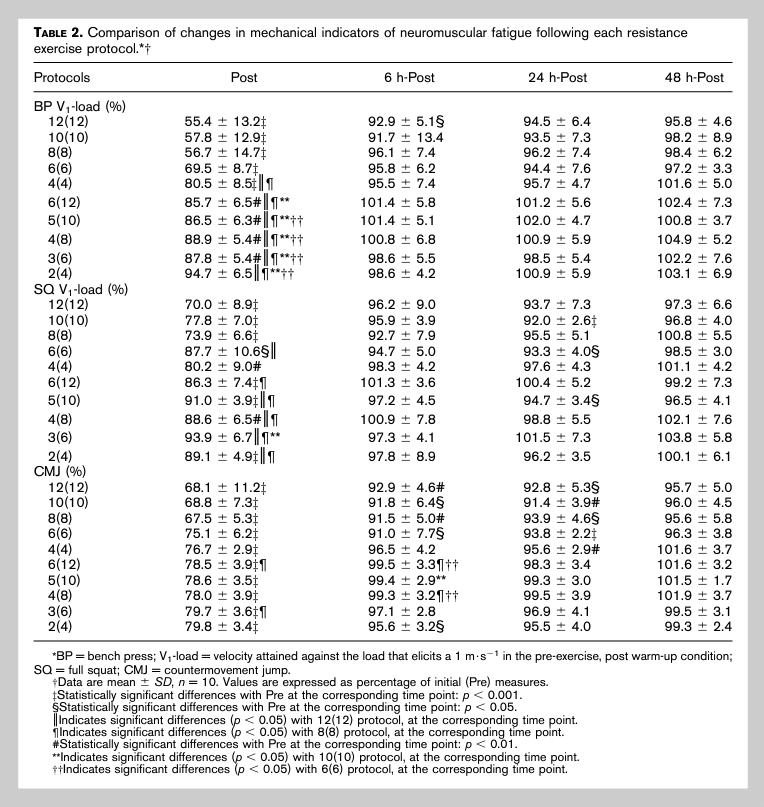How long should you rest after a hard session?
Last week, we discussed the recent meta-analysis on how close to failure you should train for muscle hypertrophy.
One question that may have sprung into your mind is:
“Sure, training closer to failure is better for muscle growth, but what about fatigue?”
Read time: 6-8 minutes
Take-aways
Performing 3 sets to failure can take >48 hours to recover from fully, at least when this is a novel stimulus. Staying 2-6 reps shy of failure can reduce the timeline for recovery to ~24 hours.
If you’re doing 5+ sets relatively close to failure for a muscle within a session, you should probably rest it at least 48 hours before training it again. If you’re doing <5 sets and/or not going to failure, you can probably train it again the next day.
If you’re getting ready to max-out or compete in a strength sport, you probably want >72 hours between your last hard session and the big day.
Generally, performing more repetitions per set appears to result in greater short-term fatigue than performing fewer repetitions per set. Training to failure results in greater fatigue than training shy of failure.
In all likelihood, you should still take sets close to failure and perform 5+ reps per set for muscle growth. That said, for strength, limiting the number of reps per set and staying shy of failure is a good idea to limit fatigue. This is doubly true since lower reps allow you to lift more and going closer to failure doesn’t seem to improve strength gains.
Even if you’re not fully recovered from a previous session, you can likely still benefit from a training session, especially for muscle growth. You do not need to wait until you are fully recovered to train, but you do likely want to attenuate most of the fatigue from a previous session. For most sessions, this will take 24 hours for easier sessions or up to 72 hours for higher-volume sessions where most sets are taken close to failure.
You do probably get used to training to failure, to an extent, making it less fatiguing upon repeated exposure.
This is a valid concern. If training closer to failure means you can only train a muscle group once a week and you have to heavily restrict how many sets you do, training closer to failure may actually harm your growth (1, 2).
But how long does it actually take you to recover from a hard session? What about training to failure vs training shy of failure?
This is the question a very cool study by Pareja-Blanco and colleagues sought to answer a few years back.
Methods
Over the course of 20 weeks, 10 men underwent a variety of training sessions using the squat and bench press, both to failure and shy of failure. For both the bench and squat, participants did 3 sets per session for all protocols. The loads used were a 12-repetition maximum (RM), 10RM, 8RM, 6RM and 4RM.
Sessions differed in the number of repetitions performed; participants either performed as many reps as possible (e.g. 12 repetitions with their 12RM) or half the reps they were capable of (i.e. 6 repetitions with their 12RM), staying shy of failure. So, the 10 protocols were (12(12)), (6(12)), (10(10)), (5,(10)), (8(8)), (4,(8)), (6(6)), (3(6)), (4(4)) and (2(4)).
In other words, the authors were looking at both the impact of training to failure and of performing different repetition numbers on fatigue and recovery time course.
The researchers assessed a variety of markers of fatigue, including assessing performance directly. These assessments were performed all the way from right after a session to 48 hours following a session.
Mechanical measurements included jump tests, testing squat and bench press strength. Blood measurements included Cortisol, Testosterone, Growth Hormone, IGF-1, Prolactin and Creatine Kinase.
Training to failure generally resulted in more fatigue than training 2-6 repetitions shy of failure. In fact, when performing 3 sets to failure, performance was still usually depressed even 48 hours after the session was completed. When performing 3 sets shy of failure, on the other hand, performance generally recovered within 6-24 hours.
Recovery timecourse of performance.
Hormonally, the findings supported the recovery time-line seen with performance. Training closer to failure generally resulted in greater muscle damage (Creatine Kinase). Interestingly, increases in serum anabolic hormones were greater with both training to failure but also with performing a greater number of repetitions (e.g. 12 vs 4).
Why?
The authors hypothesized that the increased fatigue cost of training to failure has to do with depletion of certain energy sources (ATP, ADP, AMP) within the muscle. Previous data has shown that training to failure results in drastic depletion of these energy sources compared to training shy of failure. Replenishing these energy sources can take several days!
If you’d like to chat about this study, feel free to comment below.
If you’re looking for an expert to handle your training and nutrition for you, check out our coaching services.



